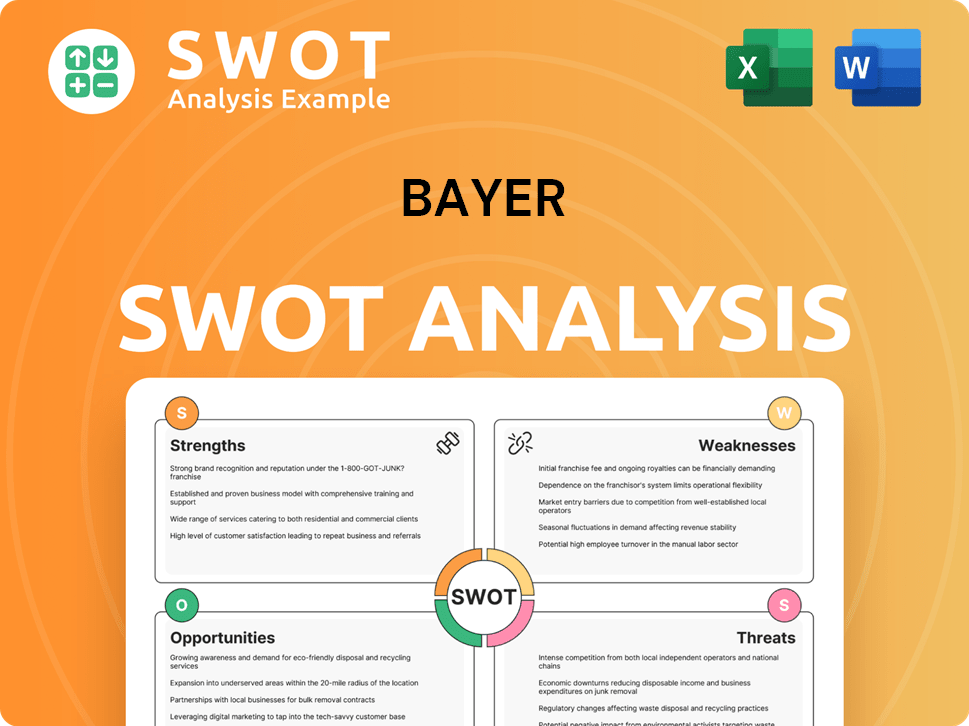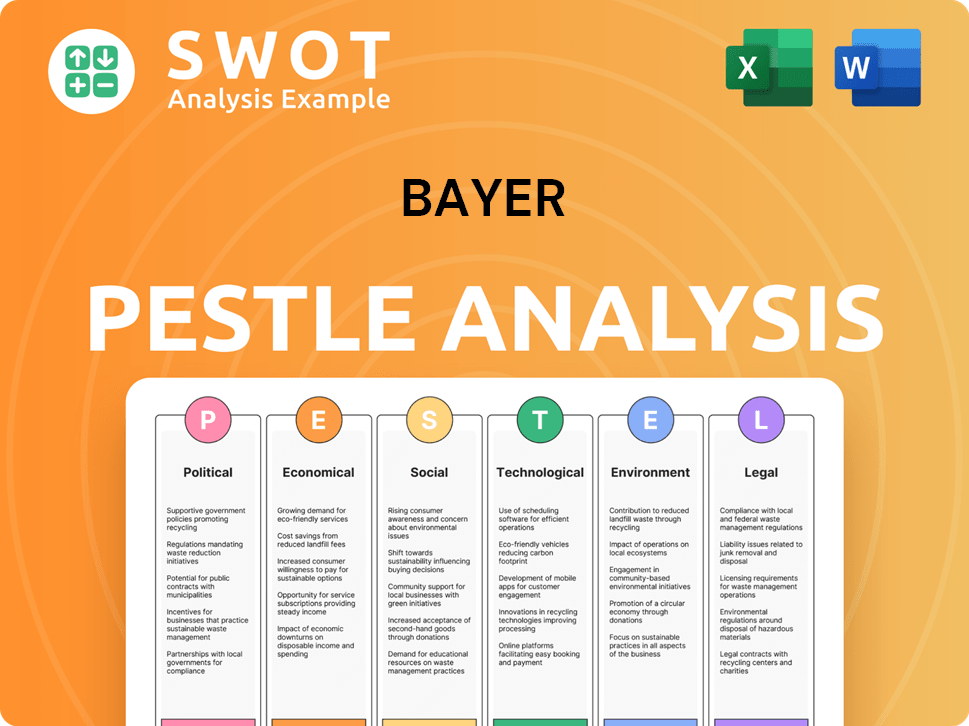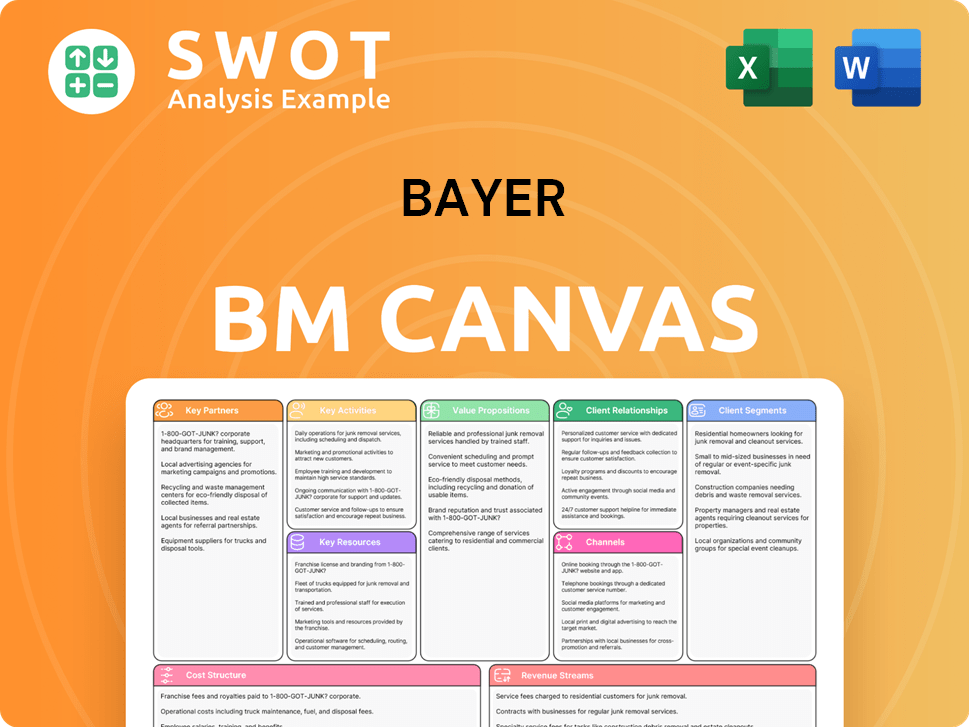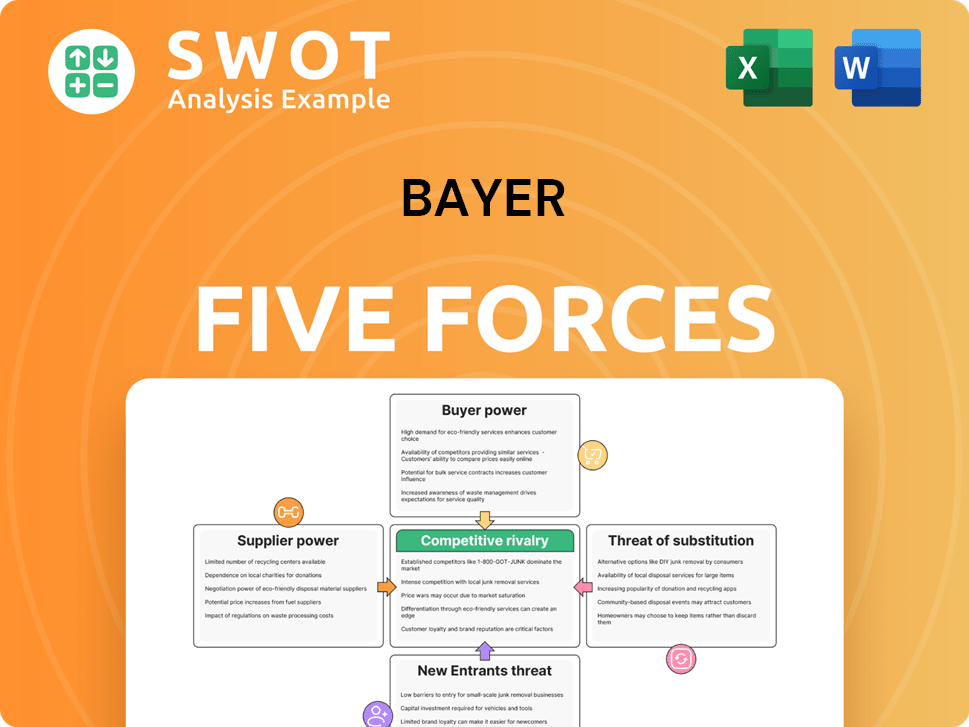Bayer Bundle
How Well Do You Know the History of Bayer?
Journey back in time to discover the captivating Bayer SWOT Analysis of Bayer AG, a German pharmaceutical company that has shaped the course of medicine and agriculture. From its humble beginnings in 1863 as a dye manufacturer, Bayer has consistently redefined scientific boundaries. Explore the pivotal moments and groundbreaking innovations that have solidified its place as a global leader.

The history of Bayer is a testament to the power of innovation and strategic vision. Understanding the early history of Bayer company, including its invention of Aspirin and its role in the chemical industry, provides crucial context for its current operations. This exploration will uncover the key events and decisions that have shaped Bayer's legacy and its enduring impact on the world.
What is the Bayer Founding Story?
The story of the Bayer company began on August 1, 1863. Friedrich Bayer, a dye salesman, and Johann Friedrich Weskott, a master dyer, joined forces in Barmen, Germany, to create 'Friedr. Bayer & Co.' Their vision was to capitalize on the emerging synthetic dye industry.
This marked the inception of what would become a global powerhouse. The founders aimed to solve the limitations of natural dyes, which were inconsistent and scarce, thus hindering the textile industry. Their business model focused on the efficient production and distribution of these innovative synthetic dyes.
The early success of the company in the dye market quickly established its reputation. Initial funding likely came from the founders' personal capital. The mid-19th century, with the Second Industrial Revolution and increasing demand for industrial chemicals, provided a favorable environment for Bayer's establishment and growth. This period set the stage for the Bayer history we know today.
Friedrich Bayer and Johann Friedrich Weskott founded the company in 1863 in Barmen, Germany. They focused on synthetic dyes, a new technology at the time.
- The company's initial focus was on synthetic dyes, which were a revolutionary alternative to natural dyes.
- The founders' expertise in chemistry and sales was key to their early success.
- The Second Industrial Revolution created a favorable environment for the company's growth.
- Initial funding came from the founders' personal capital.
Bayer SWOT Analysis
- Complete SWOT Breakdown
- Fully Customizable
- Editable in Excel & Word
- Professional Formatting
- Investor-Ready Format

What Drove the Early Growth of Bayer?
The early growth of the Bayer company, a significant part of the Bayer history, was marked by rapid expansion in dye production and a strategic move into pharmaceuticals. Founded in 1863, the company quickly became a leading producer of synthetic dyes, which fueled investment in research and development. This early success set the stage for the pivotal introduction of pharmaceuticals, significantly altering Bayer's business model.
Bayer's initial focus was on the production of synthetic dyes, quickly establishing itself in the chemical industry. This early success provided the financial foundation for research and development. The company invested heavily in its Leverkusen, Germany facilities, which became its headquarters, to support this growth.
Driven by the expertise of its chemists, Bayer expanded into pharmaceuticals in the late 19th century. This strategic diversification was a pivotal moment in the history of Bayer. The introduction of Aspirin in 1897, the Bayer's invention of Aspirin, marked a significant shift in its business model.
Aspirin (acetylsalicylic acid) quickly became a global sensation, solidifying Bayer's reputation as an innovator in medicine. The product remains a cornerstone of the company's consumer health portfolio. By the early 20th century, Aspirin was being sold in over 20 countries, demonstrating its widespread acceptance.
Bayer expanded its facilities in Leverkusen and established sales offices and production facilities internationally. Early team expansion included chemists, pharmacologists, and sales representatives. Leadership transitions evolved the company's structure, enabling strategic growth. By 1913, Bayer employed over 10,000 people worldwide.
Bayer PESTLE Analysis
- Covers All 6 PESTLE Categories
- No Research Needed – Save Hours of Work
- Built by Experts, Trusted by Consultants
- Instant Download, Ready to Use
- 100% Editable, Fully Customizable

What are the key Milestones in Bayer history?
The Bayer history is marked by significant achievements. The German pharmaceutical company has evolved over more than a century, expanding its reach and impact across various sectors.
| Year | Milestone |
|---|---|
| 1863 | Friedrich Bayer and Johann Friedrich Weskott founded the company in Barmen, Germany. |
| 1899 | The company registered Aspirin as a trademark, which quickly became a global success. |
| 1930s | Bayer introduced Prontosil, a groundbreaking antibiotic, leading to a Nobel Prize. |
| 2018 | Bayer acquired Monsanto for approximately $63 billion, expanding its crop science division. |
| 2024 | Bayer divested its Environmental Science Professional business to Cinven, streamlining its portfolio. |
Throughout its history, the
The invention of Aspirin revolutionized pain relief and remains a widely used medication globally. This innovation significantly impacted medicine and the treatment of various conditions.
The introduction of Prontosil in the 1930s marked a major advancement in treating bacterial infections. This innovation earned Gerhard Domagk a Nobel Prize and transformed medical practices.
Bayer has developed innovative solutions for crop protection, enhancing agricultural productivity. These advancements include herbicides, insecticides, and fungicides, contributing to modern farming practices.
Bayer has made significant contributions to medical imaging, improving diagnostic capabilities. These technologies enable more accurate and timely diagnoses, supporting better patient outcomes.
Bayer is focusing on cell and gene therapy, with the market for gene therapy projected to reach $25.5 billion by 2027. Cell therapy is expected to reach $60.1 billion by 2030, indicating substantial growth.
Bayer has established numerous partnerships to expand its research and development capabilities and market reach. These collaborations facilitate innovation and accelerate the development of new products.
Despite its successes, the
Bayer faces the challenge of navigating complex regulatory environments in the pharmaceutical and agricultural industries. Compliance with evolving regulations requires significant resources and expertise.
Intense competition in the pharmaceutical and agricultural sectors poses a constant challenge. Maintaining market share and driving innovation require substantial investment in research and development.
Bayer has faced significant legal challenges related to products like Roundup, impacting its financial performance and reputation. These lawsuits have led to substantial settlements and ongoing litigation.
The acquisition of Monsanto brought substantial legal liabilities and public scrutiny. Integrating Monsanto's operations and addressing associated challenges has been a complex undertaking.
Bayer has undertaken restructuring efforts and strategic repositioning to address challenges, including divesting non-core assets. This includes the 2024 divestiture of its Environmental Science Professional business.
The company has faced increased public scrutiny regarding its products and business practices. Addressing environmental concerns and ensuring product safety remain critical priorities.
Bayer Business Model Canvas
- Complete 9-Block Business Model Canvas
- Effortlessly Communicate Your Business Strategy
- Investor-Ready BMC Format
- 100% Editable and Customizable
- Clear and Structured Layout

What is the Timeline of Key Events for Bayer?
The Bayer company, a prominent German pharmaceutical company, has a rich history. Founded in 1863, Bayer has evolved from a dye manufacturer to a global leader in pharmaceuticals, consumer health, and crop science. Its journey includes groundbreaking discoveries like Aspirin and strategic acquisitions, shaping its current structure and future direction. The company's timeline reflects its adaptability and commitment to innovation, highlighting its significant contributions to medicine and agriculture.
| Year | Key Event |
|---|---|
| 1863 | Friedrich Bayer and Johann Friedrich Weskott founded the company in Barmen, Germany. |
| 1897 | Bayer introduced Aspirin (acetylsalicylic acid), a revolutionary pain reliever. |
| Early 1900s | Bayer expanded into pharmaceuticals and international markets, growing its global presence. |
| 1930s | The discovery of Prontosil, the first sulfonamide antibiotic, marked a significant medical advancement. |
| Post-WWII | Bayer rebuilt and re-established itself as a leading chemical and pharmaceutical company. |
| 1970s-1980s | Continued global expansion and diversification into new chemical and healthcare areas occurred. |
| 2000s | Bayer strategically focused on life sciences, including pharmaceuticals, consumer health, and crop science. |
| 2018 | The acquisition of Monsanto significantly expanded its Crop Science division. |
| 2020-2024 | Bayer intensified its focus on innovation in cell and gene therapy and sustainable agriculture. |
| 2024 | Divestment of Environmental Science Professional business to Cinven was completed. |
Bayer is currently concentrating on driving innovation within its core life science sectors: Pharmaceuticals, Consumer Health, and Crop Science. This strategic emphasis is designed to address unmet medical needs through advancements in cell and gene therapies, as well as sustainable agricultural practices. The company's commitment to research and development is evident in its robust pipeline of candidates.
The company anticipates substantial growth in its Pharmaceuticals, Consumer Health, and Crop Science divisions. This growth is projected to be driven by worldwide demographic changes and an increasing global demand for health and nutrition solutions. Analysts predict ongoing investments in research and development, specifically focusing on digital transformation and precision agriculture within these sectors.
Bayer is deeply committed to sustainable agriculture, developing solutions to increase crop yields while minimizing environmental impact. The company's future outlook is rooted in its founding vision of applying scientific discovery to improve lives, which now extends globally with a strong emphasis on sustainability and cutting-edge biotechnology. These initiatives are crucial for long-term value creation.
Leadership statements emphasize a commitment to innovation, sustainability, and delivering long-term value to stakeholders. Bayer's strategic direction is guided by a commitment to these principles, ensuring that the company continues to contribute positively to global health and agricultural advancements. This focus helps maintain stakeholder confidence and drive future success.
Bayer Porter's Five Forces Analysis
- Covers All 5 Competitive Forces in Detail
- Structured for Consultants, Students, and Founders
- 100% Editable in Microsoft Word & Excel
- Instant Digital Download – Use Immediately
- Compatible with Mac & PC – Fully Unlocked

Related Blogs
- What is Competitive Landscape of Bayer Company?
- What is Growth Strategy and Future Prospects of Bayer Company?
- How Does Bayer Company Work?
- What is Sales and Marketing Strategy of Bayer Company?
- What is Brief History of Bayer Company?
- Who Owns Bayer Company?
- What is Customer Demographics and Target Market of Bayer Company?
Disclaimer
All information, articles, and product details provided on this website are for general informational and educational purposes only. We do not claim any ownership over, nor do we intend to infringe upon, any trademarks, copyrights, logos, brand names, or other intellectual property mentioned or depicted on this site. Such intellectual property remains the property of its respective owners, and any references here are made solely for identification or informational purposes, without implying any affiliation, endorsement, or partnership.
We make no representations or warranties, express or implied, regarding the accuracy, completeness, or suitability of any content or products presented. Nothing on this website should be construed as legal, tax, investment, financial, medical, or other professional advice. In addition, no part of this site—including articles or product references—constitutes a solicitation, recommendation, endorsement, advertisement, or offer to buy or sell any securities, franchises, or other financial instruments, particularly in jurisdictions where such activity would be unlawful.
All content is of a general nature and may not address the specific circumstances of any individual or entity. It is not a substitute for professional advice or services. Any actions you take based on the information provided here are strictly at your own risk. You accept full responsibility for any decisions or outcomes arising from your use of this website and agree to release us from any liability in connection with your use of, or reliance upon, the content or products found herein.